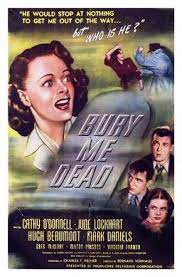
A raging fire engulfs a barn belonging to the Carlin estate. A body found in the fire is believed to be that of Barbara Carlin (June Lockhart). The body was identified by a diamond necklace and a compact. Her husband Rod (Mark Daniels) appears distraught. The attorney for the family, Michael Dunn (Hugh Beaumont) arrives to console the family. Everyone shows up for the funeral except Barbara’s neurotic airhead sister Rusty (Cathy O’Donnell). Even Barbara shows up.
Barbara had been out of town and was not the person who died in the fire. Believing that someone wants to kill her Barbara is cautious about contacting the family. Her first contact is Michael. Michael wants her to contact the police but Barbara wants to find out more before does. Her first thought is of Rusty. Some woman died in the fire and Rusty wasn’t at the funeral. Rusty turns up alive and well but not real happy to see Barbara. She blames Barbara for her life not being how she wants. But Rusty isn’t the only one who harbors a grudge.
In a series of flashbacks Barbara tries to identify who may hate her enough to kill her. When Barbara’s father died it is revealed that Rusty was an orphan taken in by the Carlin family but never really adopted. This means Rusty doesn’t share in the family fortune. Barbara then married Rod. Rusty was in love with Rod and blames Barbara for taking him away from her.
Barbara and Rod begin having marital trouble and Barbara believes that Rod only married her for her money and has been having an affair with a woman named Helen Lawrence (Sonia Darrin). Helen wants Rod to get rid of his wife so they can be married. Helen is the assistant to a boxer named George Mandley (Greg McClure). George was seeing Rusty until Barbara interfered. Helen and George have their own secrets. Lots of motives and lots of suspects. The whole affair could have been a soap opera but a woman is dead and Barbara is still in danger.
“Bury Me Dead” was released in 1947 and was directed by Bernard Vorhaus. It is a film noir and a mystery with comedy elements. The film is a poverty row produced film from Producers Releasing Corporation and was distributed by Eagle-Lion films. The film, at only an hour and eight minutes, was pared down to a half hour and sold as part of a syndicated television mystery show.
Not long after the movie was competed director Vorhaus was blacklisted due to the House Un-American Activities Committee (HUAC) by the Senate in 1947.
The movie could have been your basic noir with dramatic hyperbole but the comedy elements were a surprise and added a refreshing element to the film. Add to that some great noir lighting elements by cinematographer John Altman and a rather well done music score by Emil Cadkin and the film took on an interesting and exciting dimension. Toss in some actors that know their stuff and you’ve got a good movie. It ended up highly entertaining.

